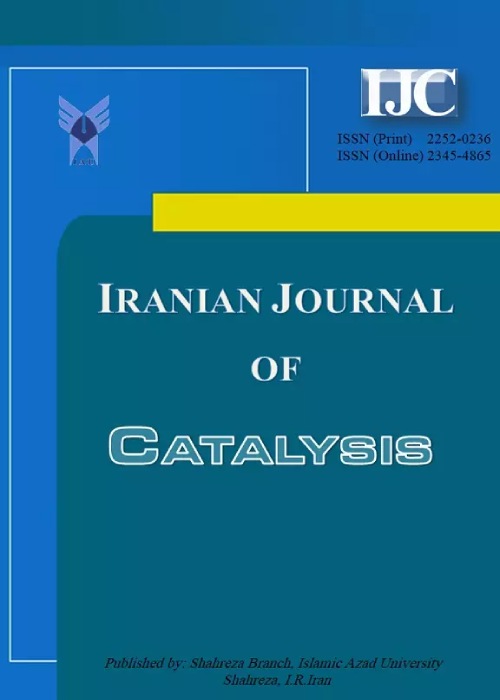فهرست مطالب
Iranian Journal of Catalysis
Volume:1 Issue: 2, Autumn 2011
- تاریخ انتشار: 1390/09/15
- تعداد عناوین: 8
-
-
Pages 51-54A convenient, rapid, and one-pot method for the synthesis of azo dyes has been developed. In this protocol, diazotization reagent (ArN2+ -CrO3–SiO2) was prepared via grinding of aromatic amines, NaNO2, wet SiO2 and nano silica chromic acid (Nano-SCA) without solvent at room temperature. The obtained diazotization reagent was sufficiently stable to be kept at room temperature in the dry state for long time. Azo dyes were prepared by coupling of ArN2+ -CrO3–SiO2 with 1-naphthoxide in good to excellent yields. Mild and heterogeneous reaction conditions, high stability of diazonium salt, easy procedure, short reaction time and high yields are some important advantages of this protocol.
-
Pages 55-63A simple and green synthetic strategy to prepare BaO/TiO2-ZrO2 as a solid base catalyst was reported. These materials with various amounts of BaO were prepared by the adsorption method. The physical and chemical properties of BaO/TiO2-ZrO2 were investigated by X-ray diffraction, X-ray fluorescence, specific surface area and BJH pore size distribution, FT-IR spectroscopy, scanning electron microscopy and energy dispersive spectra techniques. The catalytic performance of catalyst was determined for the Knoevenagel condensation reaction between carbonyl compounds and ethyl cyanoacetate in the presence of water as a solvent. The catalyst used for this synthetically useful transformation showed considerable level of reusability besides very good activity.Keywords: Solid base catalyst, BaO, TiO2, ZrO2, Knoevenagel condensation
-
Pages 65-70The use of methanesulfonic acid as a Brønsted acid for direct ortho-acylation of phenols and naphthols proves to be a convenient, more general and direct route to various hydroxyaryl ketones. The route is regioselective, leading to ortho C-acylated products in satisfactory to high yields in most cases. The solvent free reactions described below exhibited environmentally benign in terms of faster reaction, benign conditions and higher yield of the desired products. The influence of the temperature, the ratios of the reactants and the amounts of MSA were investigated. However, after a 10-18 minute reaction time at 60-100 °C, selectivity to over 98% ortho acylation products was obtained. This method represents an environmentally benign acylation route, because MSA is biodegradable acid which can easily be separated from the reaction mixture via decantation.Keywords: Solvent Free, Methanesulfonic acid, Friedel–Crafts, ortho, Acylation, Regioselective
-
Pages 71-78Sulfuric acid ([3-(3-silicapropyl)sulfanyl]propyl]ester (SASPSPE) is employed as a recyclable catalyst for the silylation of hydroxyl groups. A good range of primary, secondary alcohols and phenolic hydroxyl groups were effectively converted into their corresponding trimethylsilyl ethers with examethyldisilazane in the presence of catalytic amounts of SASPSPE at room temperature with short reaction times in good to excellent yields. This heterogeneous catalyst was recycled for nine runs without losing its catalytic activity.Keywords: Sulfuric acid ([3, (3, silicapropyl)sulfanyl]propyl)ester, Silylation, Catalyst, Hydroxyl group, Heterogenous solid acid
-
Pages 79-86A direct and an efficient conversion of a wide range of primary, secondary even tertiary alcohols to the corresponding iodides have been achieved under ionic liquid conditions. The method involves preparation of ionic liquid-based iminium chloride intermediate from DMF-like ionic liquid then stirring it with alcohol in present of sodium iodide. The higher yields of alkyl iodides were obtained within minimum time with simplest operational procedure. The DMF-like ionic liquids could be recycled.Keywords: DMF, like ionic liquid, Iminium chloride, Vilsmier reagent, Thioiminium salt, Alcohols, alkyl iodides
-
Pages 87-92Nano-silica supported boron trifluoride (BF3.SiO2) is an efficient, reusable and eco-friendly catalyst for chemoselective thioacetalization of aldehydes and ketones. So, this catalyst was applied for transthioacetalization of acetals and acylals into their corresponding 1,3-dithiolanes or 1,3-dithianes in good to excellent yields. The reactions were carried out at room temperature under solvent free and grinding conditions in 1.5-2.5 minutes.Keywords: BF3.SiO2, Nano, BF3.SiO2, Thioacetal, Thioacetalization, Trans, thioacetalization, Protecting group
-
Pages 93-97An efficient synthesis of polyhydroquinoline derivatives was reported via four-component coupling reactions of aldehydes, 1,3-dicarbonyl ketones (dimedone or 1,3-cyclohexanedione), ethyl acetoacetate or methyl acetoacetate and ammonium acetate in the presence of a catalytic amount of nanocrystalline TiO2 under solvent free conditions. The reported method is mild, rapid and has the advantages such as heterogeneous catalysis, simple work-up procedure, recyclability of the catalyst and purification of products without chromatographic methods.Keywords: Nanocrystalline TiO2, Hantzsch reaction, Polyhydorquinolie derivatives, Heterogeneous catalysis, one, pot condensation reaction
-
Pages 99-104A comparison of the photoefficiency of Ni(II) and NiS incorporated into zeolite P towards photodecolorization of Eriochrome Black T dye solution was investigated in a photocatalytic reactor using UV lamp as a light source. The effect of various experimental variables on the decolorization performance of the process was evaluated by examining catalyst dosage, temperature, initial dye concentration and pH of the dye solution. The obtained results showed better efficiency of NiS/P than Ni/P catalyst. The decolorization process in both case obeyed first-order kinetics.Keywords: Eriochrome Black T, NiS, Photodecolorization, Zeolite P, Heterogeneous catalysis


